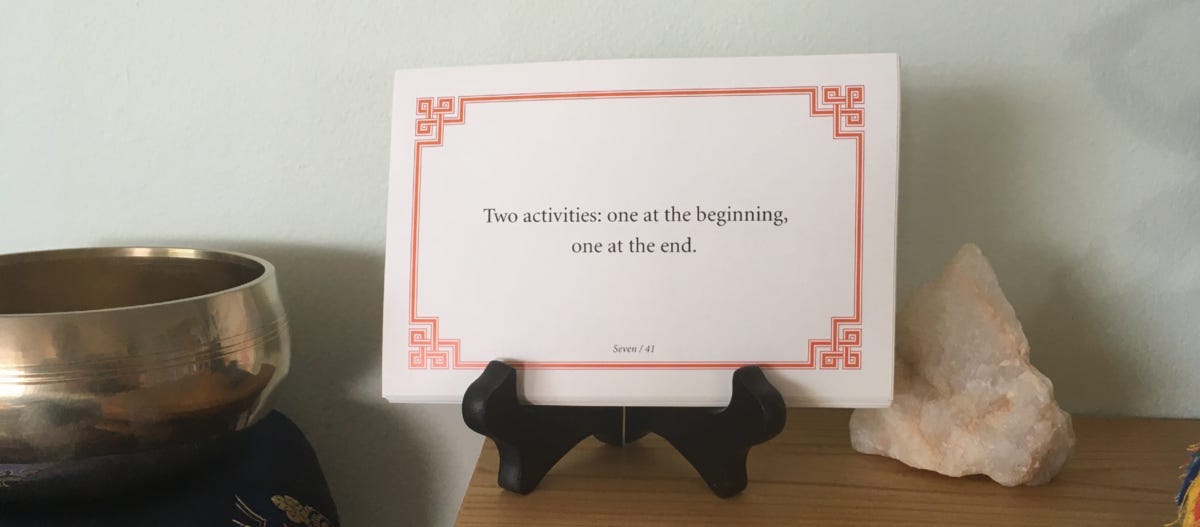Lojong Practice Journal: Two activities: One at the beginning, one at the end
The 59 slogans through a social justice lens
Buddhism is referred to as a practice because it calls us to continuously study, reflect on, and integrate wisdom into our lives. This cyclical approach is often referred to as the ground (the inherent potential we all have for waking up), the path (the action we take towards our own awakening), and fruition (the moments of realization we have that can never again be obscured). The slogan, “Two activities: one at the beginning, one at the end” is a practical and simple guide for how we can ensure we are consistently engaged in this cycle, no matter the circumstances.
The two activities are simple:
1. Start everything with a clear intention.
2. End everything with a dedication for what was of benefit and a resolve to learn and do better for anything that wasn’t of benefit.
This can be used as a way to top and tail your day, the start and finish of a project or retreat, or for any collaborative activity.
The first step, setting an intention, is about living by vow. It’s been shown that when people recite a vow of honesty before responding to a questionnaire or text, they are less likely to embellish their responses or cheat. There’s something about the psychology of stating an intention that impacts our actions.
As a practice, the second step honours the fact that karma is not about fate but about possibility. If our intention for the day was to be kind, we can reflect and honour all the ways we expressed kindness while also genuinely looking at the times we didn’t, and set the intention to do better moving forward. In this way, we can learn to see regret as a teacher — a sign-post to a growing edge rather than a burden and something we use to beat ourselves up.
Combined, these two activities help us to integrate wisdom into our lives, regardless of the context of our reality.
When land acknowledgements started to become a regular thing, I had no personal relationship with them. It wasn’t until I was leading a group that it occurred to me I probably should do a land acknowledgement. I said as much, and am grateful that one of the participants said that it was important that land acknowledgements are done with intention and not just because we think we should.
So I set the intention for myself to actively engage in learning about the practice of land acknowledgements. I also set the intention to learn more about decolonialism, water protectors, and the Land Back movement. Whenever I was hosting a space, I tried different ways of doing land acknowledgements, and invited reflections and resources from others. Afterwards, I reflected on how it felt in my own body and mind. In the beginning, the intention is to learn. In the end, I reflected on what I was learning, what I am still learning.
Over time, my relationship to land acknowledgements has gone from that of a detached observer to being a genuine practice of the heart. I’ve learned that it’s as much about acknowledging the Indigenous Nations on whose land I am living, as it is about seeing my own relationship and responsibility to the land.
I can never say this enough: the form is not the practice. This slogan gives us a form, a simple two-step process we can apply to specific situations or just generally to our day-to-day lives. How we apply it is entirely up to us, but it’s applications are truly endless.
Originally published on Medium.
This is part of a series of posts I did to support my practice. They will always be free for everyone to read and engage with, but if you want to support me financially, that is greatly appreciated. Tips, paid subscription, and regular e-transfers* help me cover the costs of being a creative human being in the world.
Toodle on over to www.KSCHatch.com to find out more about what I do.
Thank you!
*If you are in Canadia, you can send me a one off or ongoing e-transfer using the email faunawolf ‘at’ gmail ‘dot’ com
Lojong Practice Journal Index
The following is an index of my commentaries on the Lojong Slogans (also known as the Seven Points of Training the Mind) in the order they are listed, rather than the order in which I published them. May they be of benefit. ~ Point One: The preliminaries and therefore basis of the practice






Ah! Here comes what I thought of for slogan 39. I was ahead of myself it would seem. But there is a slight difference between the two sets of practices. The one I mentioned under slogan 39 is about creating and dedicating merit. But there is more to intention than the distribution of merit. If we look at our intentions we become more self-aware. What am I going to do today? Why am I going to do it? How am I going to do it? And later: Did I do what I set out to do? Am I satisfied with the outcome?
We need to create more gaps in our life where we can pause and ask ourselves questions like these. We have to "Stop, look and listen". The song might not exactly describe what I mean (it is a bit too energetic) but the title fits and makes for a catchy slogan. 😊